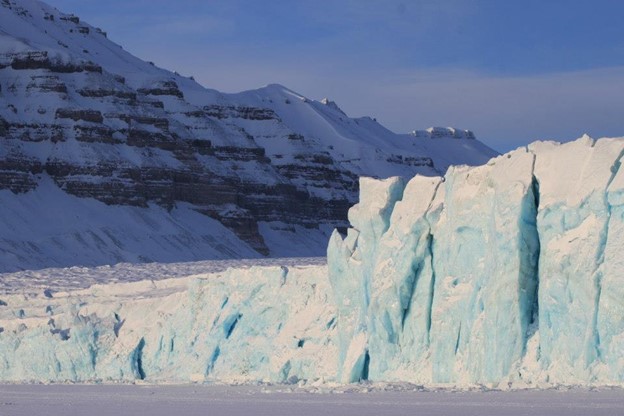 Earth & Space
Earth & Space
How glaciers can help algae bloom under sea ice
While invisible to the bare eye, microscopic algae are the base of marine food webs, eventually feeding large animals, such as fish and whales. These algae need sunlight and nutrients to grow. But only little light penetrates sea ice during the Arctic winter. In a high-Arctic fjord, we found a unique system where algae thrive under sea ice, fueled by meltwater from below a glacier.

With global warming, glaciers are melting rapidly in the Arctic. This meltdown leads to globally rising sea-levels and locally affected marine ecosystems. In summer, glaciers that are in direct contact with the sea are known biological hotspots. Large amounts of glacial meltwater enter the fjord mostly from below the glacier, at depths that can reach several hundred meters below the sea surface. Since the glacial meltwater is lighter than seawater, it rises to the surface, like an inverted waterfall; a process known as subglacial upwelling. On its way up, the water mixes with deep and nutrient-rich bottom water masses. These nutrients can then fuel algae production near the surface. In winter, however, air temperatures are below the freezing point and glacial meltwater inputs are assumed to be insignificant.
In a new study, we found a unique system in a Svalbard fjord where algae can bloom early under snow-covered sea ice, while air and water temperatures are still below 0°C. We found an over 200 times higher algae production at the front of a glacier ending in the fjord, compared to a reference site eight kilometers away. This Arctic glacier in direct contact with the fjord, released meltwater from its base, changing drastically the environment under the sea ice in favor of algae growth. How did algae manage to thrive under these harsh conditions? Firstly, more light penetrated the sea ice due to a thinner snow cover and less sea ice algae in the ice. As a result, two times more sunlight reached the algae below, compared to the levels observed at the reference station. Secondly, a two-meter thick, low-salinity water layer below the ice kept the algae in the bright surface layer, preventing mixing into deeper water layers. And thirdly, the meltwater exiting the glacier rose together with deep nutrient-rich water masses to the surface, feeding the algae.
Although algae were blooming under the sea ice, in the sea ice itself, the impacts were very different. There, microscopic organisms typically live in a network of channels filled with very salty and cold liquids, known as brine channels. The meltwater at the glacier front led to an ice structure with substantially smaller and disconnected brine channels. Consequently, algae had only little place to grow, and nutrient exchange with the underlying water was inefficient. We found not only much less algae than at the reference site, but also smaller dominant species. The ice algae at the glacier front were unusual for Arctic marine sea ice, but more comparable to what we find in other brackish systems, such as the Baltic Sea.
Earlier studies assumed that meltwater from below glaciers is insignificant when air temperatures are below the freezing point. Our research shows that this is not the case. The thick ice of the glacier insulates the bottom from the freezing air, allowing the meltwater to persist in winter and exit the glacier into the fjord. While few recent studies also found evidence of this winter meltwater in Greenland, we are the first to find that this process can have substantial impacts on the fjord ecosystem. Even low meltwater fluxes can lead to higher algae production under the ice, while algae inside the ice are severely limited by space and nutrient exchange. But is this an isolated case in a very specific Svalbard fjord, or is winter meltwater below glaciers a key, but overlooked process throughout the Arctic? With rapidly melting glaciers all over the Arctic, we have only little time to find out.
Original Article:
Vonnahme, T. et al. Early spring subglacial discharge plumes fuel under-ice primary production at a Svalbard tidewater glacier. The Cryosphere 15, 2083-2107 (2021).Next read: Will we soon witness the first summer without Arctic sea ice in 130,000 years? by Maria Vittoria Guarino
Edited by:
Polyxeni Damala , Senior Scientific Editor
We thought you might like
Warm waters hide in the unlikeliest of places – under the Arctic sea ice
Jul 31, 2019 in Earth & Space | 3.5 min read by Mary-Louise TimmermansRecent Rapid Changes in Antarctic Sea Ice Coverage
Jan 8, 2020 in Earth & Space | 4 min read by Claire ParkinsonMore from Earth & Space
Discovery of the first radiation belt beyond the Solar System
Jan 27, 2025 in Earth & Space | 3.5 min read by Juan Bautista Climent OliverOne million (paper) satellites
Jan 24, 2025 in Earth & Space | 3 min read by Ewan Wright , Andrew FalleVolcanic Ash: A Nutrient Boost for Reef-Building Corals
Sep 18, 2024 in Earth & Space | 4 min read by Frank Förster , Tom SheldrakeAmmonia Energy: A Call for Environmental Awareness
Aug 29, 2024 in Earth & Space | 3.5 min read by Matteo Bertagni , Robert Socolow , Amilcare PorporatoLikely increase in coral thermal tolerance at a Pacific archipelago
Dec 29, 2023 in Earth & Space | 3 min read by Liam LachsEditor's picks
Trending now
Popular topics


